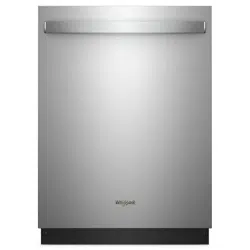Documents: Go to download!
User Manual
- User Manual - (English, French)
- Installation Instructions - (English)
- Dimensions Guide - (English)
- Warranty Guide - (English)
- Energy Guide - (English)
User Manual Dishwasher
KEY USAGE TIPS
Premium Top Rack Adjuster
You can raise or lower the top rack to fit tall items in either the top or bottom rack. Adjusters are located on each side of the top rack.
To raise the rack:
Press both rack adjuster thumb levers and lift the rack until it is in the up position and level.
To lower the rack:
Press both rack adjuster thumb levers and slide the rack to its down position and level. NOTE: The top rack must be level.

Drying – Rinse aid is essential
You must use a drying agent such as a rinse aid for good drying performance. Rinse aid along with the Heat Dry option will provide best drying and avoid excessive moisture in the dishwasher interior.
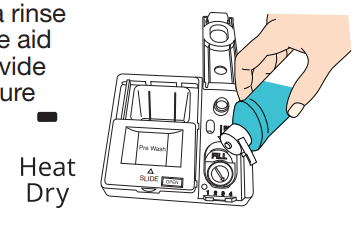
Filtration System and Maintenance
Your dishwasher has the latest technology in dishwasher filtration. This filtration system minimizes sound and optimizes water and energy conservation while providing superior cleaning. The filter system consists of two parts, an upper filter assembly and lower filter.
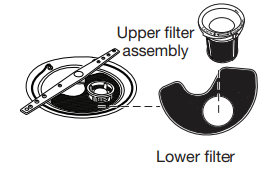
IMPORTANT: To avoid damage to dishwasher, do not operate your dishwasher without filters properly installed. Be sure lower filter is securely in place and upper filter assembly is locked into place. If the upper assembly turns freely, it is not locked into place.
The filters may need to be cleaned when:
- Visible objects or soils are on upper filter assembly.
- Dishes feel gritty to the touch.
See “Filtration System” in the full User Instructions for complete removal and maintenance schedule.
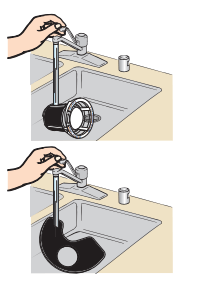
IMPORTANT: Do not use a wire brush or a scouring pad, etc., as they may damage the filters. Rinse filter under running water until soils are removed. If you have hard to remove soils or calcium deposits because of hard water, a soft brush may be required.
Energy efficiency
Energy efficiency is gained by extending cycle time and reducing the amount of wattage and water used during your dishwasher’s cycle. For exceptional cleaning, cycles are longer due to the soak and pauses.
Efficient dishwashers run longer to save water and energy, just as driving a car slower saves on gas. Your first cycle will run longer to calibrate the optical water sensor.
Press Start/Resume every time you add a dish
IMPORTANT: If anyone opens the door, such as for adding a dish (even during the Delay option), Start/ Resume must be pressed each time.
Push door firmly closed within 4 seconds of pressing Start/Resume. If door is not closed within 4 seconds, the Start/Resume button LED will flash, an audible tone will be heard, and the cycle will not start.
OPERATING YOUR DISHWASHER
1. Prepare and load the dishwasher
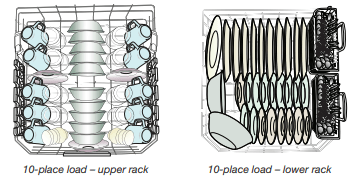
IMPORTANT: Remove leftover food, bones, toothpicks, and other hard items from dishes. Remove labels from containers before washing.
- Make sure when dishwasher door is closed, no items are blocking the detergent dispenser.
- Items should be loaded with soiled surfaces facing down and inward to the spray as shown in the graphics above. This will improve cleaning and drying results. Angle dirtiest dish surface downward, allowing space for water to flow up through rack and between dishes.
- Avoid overlapping items, like bowls or plates, that may trap food.
- Place plastics, small plates, and glasses in upper rack.
- Wash only items marked “dishwasher safe.”
- To avoid thumping/clattering noises during operation, load dishes so they do not touch one another. Make sure lightweight load items are secured in racks.
- Use slots in the covers and suggested loading patterns to keep your silverware separated for optimum wash.

- If your silverware does not fit into the designated slots, lift and slide covers off to remove them and mix silverware types to keep them separated.
- When loading silverware, always place sharp items pointing down and avoid “nesting” as shown.
2. Check that all arms spin freely
Items in the rack can block the spray arms.
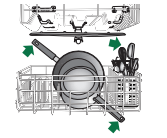
3. Add detergent
Premeasured Detergents
High-quality premeasured tablets and packs are recommended for improved performance.
Quality tablets and packs have been proven better than powder, liquid, or gel detergents at reducing filming on dishes. Using tablets and packs over time will start to reduce or eliminate white film. They are suitable for all water hardness and soil levels. Also, by using a rinse aid, you can minimize repeat buildup of white film (not all packs and tablets contain rinse aid). Always place premeasured detergents in main compartment and close lid.

NOTE: Follow instructions on the package when using other dishwasher detergent types. See the complete User Instructions for more details about powders, liquids, and gels.
- Use automatic dishwasher detergent only. Add detergent just before starting a cycle.
- Fresh automatic dishwasher detergent results in better cleaning. Store tightly closed detergent container in a cool, dry place.
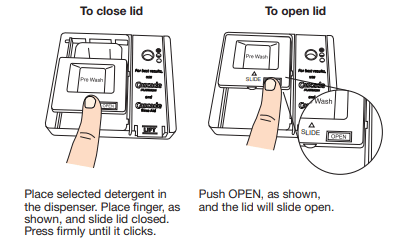
4. Add rinse aid
- Your dishwasher is designed to use rinse aid for good drying performance. Without rinse aid, your dishes and dishwasher interior will have excessive moisture. The heating and drying options will not perform as well without rinse aid.
- Rinse aid keeps water from forming droplets that can dry as spots or streaks. It also improves drying by allowing water to drain off of dishes after final rinse. Rinse aid does not adhere to dishware, and when used, it is dispensed during each cycle.
- To add rinse aid, open the dispenser lid by gently pushing in the center of the lid with your thumb while lifting up on the edge.

- Pour rinse aid into the opening until the indicator level shows that it is full.

- Close the dispenser by pushing down gently on the lid.
NOTE: For most water conditions, the factory setting will give good results. If you are experiencing poor drying performance, you may want to try a higher setting. Turn the arrow adjuster to a higher number to increase the amount of rinse aid. 
5. Select a cycle
Efficient dishwashers run longer to save water and energy, just as driving a car slower saves on gas. Typical cycle time is approximately 21 /2 hours but can take less or more time to complete depending on selections. Select a cycle (or press Start/Resume, to begin the last selected cycle).
6. Select options
You can customize your cycles by pressing the options desired. If you change your mind, press the option again to turn off the option. Not all options are available for every cycle. If an invalid option is selected for a given cycle, the lights will flash. Adding options may increase the cycle time.
7. Start or resume a cycle
NOTE: If needed, run hot water at the sink nearest your dishwasher until the water is hot. Turn off water. Push door firmly closed within 4 seconds of pressing Start/Resume. If door is not closed within 4 seconds, the Start/Resume button LED will flash and the cycle will not start.
IMPORTANT: If the door is opened for any reason after the cycle is started (even during the Delay option), the Start/Resume button must be pressed again.
8. Follow the progress of your dishwasher
The indicator LED on the front right corner of the door panel will glow while running the cycle and will go out when the cycle is complete. Also, the LED display on the control panel will light up during the cycle for Wash, Drain, Drying, Clean, and Sanitized.

CYCLE GUIDE
This information covers several different models. Your dishwasher may not have all of the cycles and options described.
IMPORTANT: The sensor in your dishwasher monitors the soil level. Cycle time and/or water usage can vary as the sensor adjusts the cycle for the best wash performance. If the incoming water is less than the recommended temperature or food soils are heavy, the cycle will automatically compensate by adding time, heat, and water as needed.
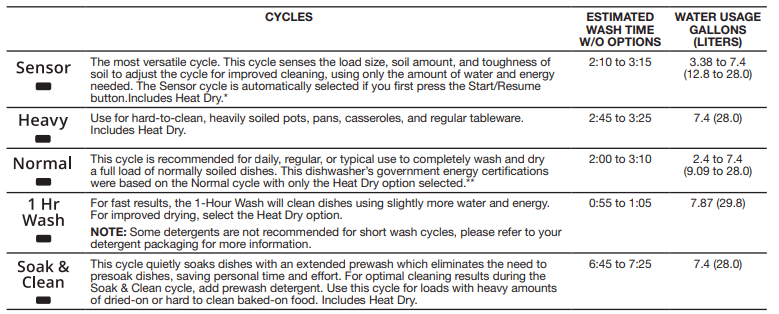
*The government energy certifications are not based on this cycle. See the Normal cycle description for the government energy certification cycle. Using the Sensor cycle may increase your energy usage. **No other washing and drying temperature options were selected, and the dishwasher was not subjected to truncated testing. Rinse aid was not used, and there was no detergent used in the prewash


DISHWASHER CARE
Cleaning the Exterior
Clean the exterior of the dishwasher with only a soft, damp cloth and mild detergent. If your dishwasher has a stainless steel exterior, it may have a coating that is resistant to fingerprints. Avoid using abrasive cleaning products on the exterior of the dishwasher.
Cleaning and Maintaining the Interior
Many detergents may leave white spots or a white residue on dishware and on the interior of the dishwasher. Over time this residue can become unsightly and could affect dishwasher performance. Use of a dishwasher cleaning product such as affresh® Dishwasher Cleaner can help to remove the residue. Monthly use of affresh® Dishwasher Cleaner is recommended to help maintain the dishwasher. Follow package directions.
NOTE: Whirlpool recommends the use of high-quality premeasured detergent tablets or packs and the use of rinse aid for dishwasher cleaning and daily care.
If you have a drain air gap, check and clean it if the dishwasher isn’t draining well.
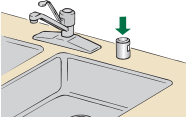
To Reduce Risk of Property Damage During Vacation or Extended Time Without Use:
- When you will not be using the dishwasher during the summer months, turn off the water and power supply to the dishwasher.
- Make sure the water supply lines are protected against freezing conditions. Ice formations in the supply lines can increase water pressure and cause damage to your dishwasher or home. Damage from freezing is not covered by the warranty.
- When storing your dishwasher in the winter, avoid water damage by having your dishwasher winterized by authorized service personnel.
TROUBLESHOOTING
1. Dishwasher does not run or stops during a cycle
It is normal for certain cycles to repeatedly pause for several seconds during the main wash. Is the door closed tightly and latched?
Is the right cycle selected?
Is there power to the dishwasher?
Has a household fuse blown or has a circuit breaker tripped? Replace the fuse or reset the circuit breaker. If the problem continues, call an electrician.
Has the motor stopped due to an overload? The motor automatically resets itself within a few minutes. If it does not restart, call for service.
Is the water shut-off valve (if installed) turned on?
2. The Clean indicator is flashing
Check the following:
- Is the overfill protection float able to move up and down freely? Press down to release.
- Be sure the water supply is turned on to the dishwasher. (This is very important following the new installation of your dishwasher.)
- Check for suds in the dishwasher. If foam or suds are detected by the dishwasher sensing system, the dishwasher may not operate properly or may not fill with water. Suds can come from:
- Using the incorrect type of detergent, such as laundry detergent, hand soap, or dish detergent for hand washing dishes.
- Forgetting to replace the rinse aid dispenser cap after filling (or refilling) the rinse aid.
- Using an excessive amount of dishwasher detergent.
3. Dishes do not dry completely
NOTE: Plastic and items with nonstick surfaces are difficult to dry because they have a porous surface which tends to collect water droplets. Towel drying may be necessary.
Use of rinse aid along with the Heat Dry option is needed for proper drying. Proper loading of items can affect drying.
Glasses and cups with concave bottoms hold water. This water may spill onto other items when you are unloading the dishwasher.
- Unload the bottom rack first.
- For improved results, place these items on the more slanted side of the rack
4. Noise
NOTE: Common noises:
- Surging sounds can occur periodically throughout the cycle while the dishwasher is draining.
- Normal water valve hissing may be heard periodically.
- A normal snap sound may be heard when the detergent dispenser opens during the cycle or when the door is opened at the end of the cycle.
- Improper installation will affect noise levels.
Be sure the filters are properly installed.
A thumping sound may be heard if items extend beyond the racks and interfere with the wash arms. Readjust the dishware and resume the cycle.
5. Spotting/Filming
Liquid rinse aid is necessary for drying and to reduce spotting.
Use the correct amount of detergent.
Confirm that the cloudiness is removable by soaking the item in white vinegar for 5 minutes. If the cloudiness disappears, it is due to hard water. Adjust the amount of detergent and rinse aid. See the “Dishwasher Care” section. If it does not come clear, it is due to etching.
Be sure the incoming water temperature is set at 120°F (49°C).
Try using the Hi-Temp Wash or Sani Rinse options.
To remove spotting, run a vinegar rinse through the dishwasher.
- Wash and rinse the affected dishware and load into dishwasher. Remove all silverware and metal items. Put 2 cups (500 mL) of white vinegar in a glass measuring cup in the lower rack. Run a Normal cycle with the Heat Dry option turned off. No detergent is needed. See “Dishwasher Care” section in full User Instructions
6. Dishwasher does not clean completely
Be sure the dishwasher is loaded correctly. Improper loading can greatly decrease the washing performance. See the “Operating Your Dishwasher” section.
Check the filter to ensure it is properly installed. Clean it if needed. See the “Filtration System” section in the full User Instructions for details.
Select the proper cycle for the type of soil. The Sensor or Heavy wash cycles can be used for tougher loads. Be sure the incoming water temperature is at least 120°F (49°C).
Use the proper amount of fresh detergent. More detergent is needed for heavier-soiled loads and hard water conditions.
Scrape food from dishes prior to loading (do not prerinse).
If foam or suds are detected by the dishwasher sensing system, the dishwasher may not operate properly or may not fill with water.
Suds can come from:
- Using the incorrect type of detergent, such as laundry detergent, hand soap, or dish detergent, for hand washing dishes.
- Not replacing the rinse aid dispenser cap after filling (or refilling) the rinse aid dispenser.
- Using an excessive amount of dishwasher detergent.
7. Dishwasher does not drain
Be sure the cycle has been completed (the Clean light is on). If it has not, you will need to resume the cycle by closing the door and pressing Start/Resume.
If dishwasher is connected to a food waste disposer, be sure the knockout plug has been removed from the disposer inlet.
Check for kinks in the drain hose.
Check for food obstructions in the drain or disposer.
Check your house fuse or circuit breaker.
See other models: YWMH31017HW WDTA50SAHB WDT780SAEM WUI75X15HB WFW6620HW
